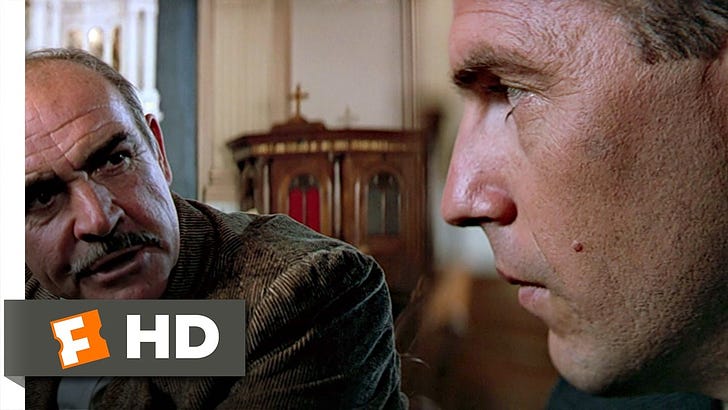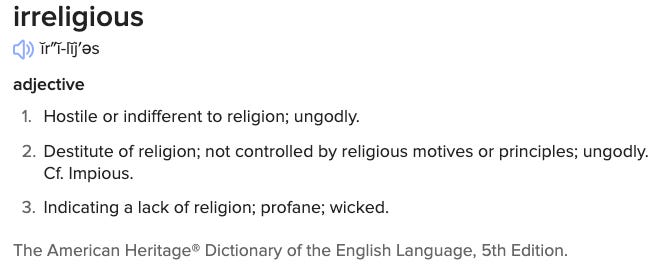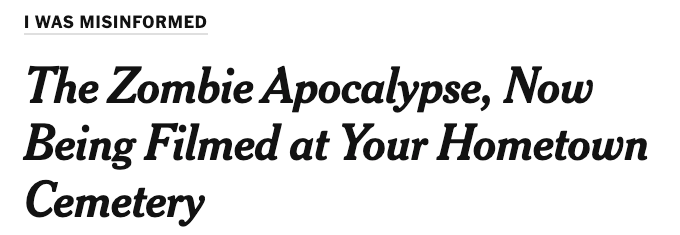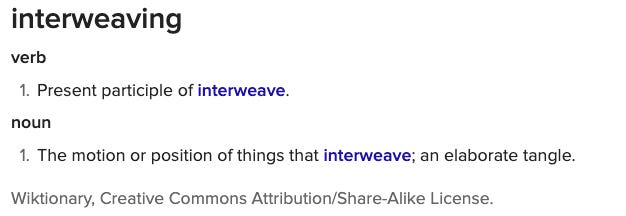New here?
Howdy, partner, and welcome to Sundman figures it out! Here you’ll find interleaving themes that emerge, fade, and reappear. Incidents ramify, and their import may change upon being revisited. Reading earlier posts will enhance your experience of reading this and subsequent essays. On that I give you my marker.
Précis
In this essay we mostly riff on this short scene from the David-Mamet-written movie The Untouchables, in which Eliot Ness (played by Kevin Costner) enlists hard-nosed Chicago flat foot Jim Malone (Sean Connery) in his quest to bring down the ruthless racketeer Al Capone:
Malone: You wanna know how to get Capone? They pull a knife, you pull a gun. He sends one of yours to the hospital, you send one of his to the morgue. That’s the Chicago way! And that’s how you get Capone. Now do you want to do that? Are you ready to do that? I’m offering you a deal. Do you want this deal?
Ness: I have sworn to capture this man with all legal powers at my disposal and I will do so.
Malone: [Takes a moment to ponder sin, grace, duty, likelihood that he’s about to sign his own death warrant, etc. . .] Well, the Lord hates a coward.
[jabs Ness with his hand, and Ness shakes it]
It takes us a while to get to our discussion of this scene, of course, and once we do get there there are digressions. But that’s as you would expect.
Ablutions
Most mornings, if I am in my own house, after my morning ablutions I stand naked in the bathroom adjacent to my bedroom. I make the sign of the cross and say, quietly, “Well, John, the Lord hates a coward,” and then I step on the bathroom scale.
I say ‘most mornings,’ because sometimes I take the coward’s way and avoid the scale. Sometimes you just don’t wanna know, y’know?
However, since my little recent unpleasant experience with tachycardia (and rides in ambulances with sirens blaring, etc), I have been virtuous regarding things related to my weight: a veritable altar boy am I, exercising in Gymnasium Pandemica even more intensely than usual, watching what I eat, and — here’s the significant bit1 — not drinking beer. So for eight weeks solid I’ve been doing that sign-of-the-cross, step-on-the-scale thing pretty much on the regular, as we say here on the South Side.
Now then, assiduous readers of Sundman figures it out! have noted that I’m irreligious despite (or perhaps because of) my inculcation in Catholic theology and custom, first by the good nuns of St. Aloysius Church in Caldwell, New Jersey, and later by the fearsome Jesuits of Xavier High School on 16th Street, Manhattan — not to mention my having been an honest-to-Fred surplice-wearing altar boy at Carmela Soprano’s home church, Notre Dame, on Central Avenue in North Caldwell.
But don’t let my doing that sign-of-the-cross thing throw you off. I’m not suddenly going all Catholic on you. I do it ironically, like an atheistic major league baseball player stepping up to the plate in the bottom of the ninth in game seven of the World Series, down by 2 runs with 2 outs and 2 men on base. Ironically, I say.
As an altar boy I did, off course, performatively assist the priest with his ablutions in the sacristy, where, according to the article Purifying Vessels Away From the Altar, on ewtn.com,
[t]he ablutions should be carried out in a climate of silence out of respect for the sacred species as well as to maintain the traditional silence observed in Catholic sacristies.
But like I said, all that Catholic stuff has nothing to do with me standing naked on the scale in my bathroom.
On book groups
I thought Joyce Wadler’s recent short substack post “Hello, Fellow Book Club Members, I Hope My Selection Doesn't Make You Despise Me” was really funny. In fact, here’s what I said about it on Substack ‘notes’:
Joyce Wadler sent me a nice email to thank me for posting this note and even comp’d me a few month’s paid subscription to her substack. There’s a lesson here, children. Say something nice about a substacker’s post and you might get an unsuspected reward. Not only that, Wadler also gave me a link to a humorous but passingly serious essay she wrote for the New York Times a few years back about a graveyard that was “closed” for the filming of a zombie movie:
Wadler’s essay touched on things like the fact that all of her close relatives except her mother were buried in that ‘closed’ graveyard — and that she (Wadler) expected her mother to join them soon — with digressions to topics including Jewish views of the putative ‘afterlife,’ and messages from beyond the grave that may or may not have been written in squiggles in the sauce on the herrings served at a post-funeral reception.
In my subsequent thank you note I told Walder about my own recent cemetery-themed post:
I Saw a Tangerine Sun Suspended in Haze Over the Cemetery Tonight
The introduction to Will Storr’s great book The Science of Storytelling begins with this paragraph: We know how this ends. You’re going to die and so will everyone you love. And then there will be heat death. All the change in the universe will cease, the stars will die, and there’ll be nothing left of anything but infinite, de…
But alas Joyce Walder did not reply, and so our conversation stopped there; she let pass the opportunity to continue talking with me either about Sundman figures it out! or about my books as suitable for recommending to book groups (which they most certainly are.)
But that doesn’t mean that you and I can’t keep talking about such things, dear reader. There’s so much for us to talk about! After all, it was in that ‘tangerine’ essay, you’ll recall, that I first mentioned Frank Kermode’s book of literary theory, The Sense of an Ending — the very tome from which I took the phrase which I use for the subtitle of the post you’re now reading, viz, “a later benefaction of significance.”
Malone’s pendulum
That short scene in The Untouchables of Ness and Malone meeting in a Catholic church and joining in a solemn pact to bring to justice the psychopathic killer Alphonse Gabriel Capone is justifiably celebrated
for the performances given by Costner and Connery;
for its cinematography, and for Malone’s explications of blood oaths and ‘the Chicago way’: “They pull a knife, you pull a gun. He sends one of yours to the hospital, you send one of his to the morgue. That’s the Chicago way!”
I have nothing to add to any of those discussions. I would like, rather, to draw your attention to the item that Malone dangles over the pew in front of where he and Ness are sitting. Joined by a short gold chain, what Malone holds, he explains, is “my call box key, and my St. Jude medallion.”
Malone: Well, the Lord hates a coward. Do you know what a blood oath is, Mr. Ness?
Ness: Yes.
Malone: Good, ’cause you just took one.
I don’t mean to talk here about the significance of those two items — the call box key, the (Catholic) Saint Jude medallion — in themselves. I mean to talk about how that little medallion swings like the little pendulum of a fist-size clock, marking time, as Frank Kermode might say, between its silent ‘tick’ and its equally silent ‘tock.’
Tick, tock; tick, tock: calling attention to Malone’s sense of his own impending ending, marking Malone’s journey to the cemetery. For he’ll meet his end in the Chicago way in Act Three, and he surely knows it.
The film does not tell us where he is ultimately laid to rest.
And furthermore, I would like to add that when I step on the scale in my bathroom I am virtually never thinking about my own mortality. I’m thinking about how much longer it’s going to take me to hit my target weight, when I will surely be as shredded as Arnold.
Interleaving vs interweaving
After I wrote the word ‘interleaving’ in the welcoming paragraph to this post it occurred to me that maybe ‘interleave’ was not actually a word. If ‘interleave’ was a word, I wondered, in what way, if any, did it differ in meaning from ‘interweave’?
You recall, naturally, that the subtitle of the third of all Sundman figures it out! essays, Easy Was, was Apologia pro substack sua, and that in that essay I made reference to how Keith Richards uses the phrase “the ancient art of weaving” to describe the interplay of guitars on Rollings Stones songs. You recall that I said that that was the effect I was aiming for in my interwoven threads in these essays.
So anyway I looked up the word ‘interleaving’ and found that it is generally used in a pedagogical context, to mean teaching a bunch of different subjects & skills — such as, frinstance, I suppose, hang gliding, modern French novels, auto mechanics and prelapsarian jurisprudence, all these in their pregnant causes mixed confusedly, as John Milton might say — and I read a few comments on the meaning of ‘to interleave’ on different websites, and the consensus seemed to be
“[w]ith interleaving, students learn by tackling a mix of related concepts, forcing the brain to work hard to recall prior learning and determine which strategies or skills to use to solve them. It’s demanding work that helps make “long-term memory solid, problem solving easier, and mastery improve.”2
So, mes chers élèves, I think that ‘interleave’ is an OK word to describe what I’m trying to do with you here in Sundman figures it out!. I’ll let it stand.
Once again
Once again we’ve run out of time & space to discuss everything on the blackboard. We didn’t even get to the meaning of ‘a later benefaction of significance.’ But that’s OK, at least we took a few steps towards it.
An update on Sundman’s Big Splash(TM)
I conclude for now with the text of a note I sent two days ago to those human seraphim, the founding subscribers of Sundman figures it out! (an open group that you should consider joining, n’est-ce pas?:
+++++++++++++++++++++++++++++++++++++++++++
I promised founding subscribers to Sundman figures it out! autographed print copies of the new editions (with new prefaces & covers, etc) of Acts of the Apostles, Cheap Complex Devices, The Pains and Biodigital, as well of the new novel Mountain of Devils, by the end of October, 2023.
For reasons given below, with my apology, I am moving back the delivery dates for these books. The new dates are as follows:
Paperback and ebook (English language) editions
December 10, 2023 (ship date):
Acts of the Apostles, Cheap Complex Devices, Biodigital, The Pains:
January 22, 2024 (ship date):
Mountain of Devils
Hardcover and slipcases (English language) editions
All titles, January 22, 2024
Reasons
This project is quite complex. It involves not only writing a novel, but arranging, among other things, the formatting, design, proofing, manufacture, distribution and marketing of all of these books (five titles). Each of these tasks has at least a handful, and in some cases more than a dozen, subtasks.
I underestimated how long it would take to accomplish some of these things and made some missteps with others. It’s just complicated and difficult; that’s all there is to it. To quote Frank Zappa, speaking to the audience as he and his band are about to play a number that is being recorded for release on a ‘live’ album3, “This has got to be it. This has got to be the one with all the right notes. And this is a hard one to play.”
Incidentally, although it may not be obvious, Sundman figures it out! is a key part of the marketing for my books. Yes, writing my substack essays does take a lot of time. But yes, I am 100% committed to it. I’ve just got to write them faster. I may have more to say about this at some point if anybody’s interested.
Personal challenges — some health related, others not — have taken me away from the project for periods of greater or lesser duration. (I’m doing much better now, thank you. Feeling 97.873% on the mend.)
Quality control. I’ve got a lot riding on this project. The cornerstone of the whole deal is the new book Mountain of Devils. If the book is not really, really good this whole thing will fizzle. And it will be really really good. It’s just not ready yet.
The Bigger Picture
I have given above the key dates for ‘deliverables.’ My master schedule for the project contains lots of internal milestones — dates by which I need to have, for example:
draft and final artwork for the covers;
‘beta’ readers identified;
manuscripts sent to proofreaders;
mechanisms in place for direct sales of all books from my website;
distribution (and pre-orders) in place for Amazon, B&N, Kobo, Overdrive, Apple, etc
podcast interviews scheduled;
Mountain of Devils manuscript sent to outside editor;
ARCs (advance review copies) distributed & tracked;
and on and on an on.
I’m also, inter alia, working on preparing Spanish language editions of all these books (which entails many of the above tasks for an entirely new market), and I’m investigating audiobooks (which make up as much as half of all sales of some books similar to mine, and exploring the idea of doing a webinar series with a well-known author friend of mine.
I may or may not provide some more details from the master schedule, depending, again, on how many people are interested in this kind of stuff.
Cheerio!
According to this post by Robert Sheldon on Techtarget, “The most significant bit (MSB) is the bit in a multiple-bit binary number with the largest value. This is usually the bit farthest to the left, or the bit transmitted first in a sequence. For example, in the binary number 1000, the MSB is 1, and in the binary number 0111, the MSB is 0.” However that is not the sense in which I am using ‘most significant bit’ here.
I have more to say about this pararaph but not now.
Roxy and Elsewhere — which is one of my all-time favorite albums. It does, in fact, have all the right notes.









Sincere apologies to Joyce Wadler, whose name I misspelled three times in the email version of this post because once or twice wouldn't have been enough. Just please ignore me & go read her substack. There's great stuff there.
P.S. One nice outcome is that I've learned that it's possible to edit the web version of a post after the email version has been sent. I had been under the impression that making an edit to a published post would cause a new email version to be generated & sent. I'm happy to have learned that I was wrong about that.
Malone: Do you know what a blood oath is, Mr. Ness?
Ness: Yes.
Malone: Good, because you just took one.